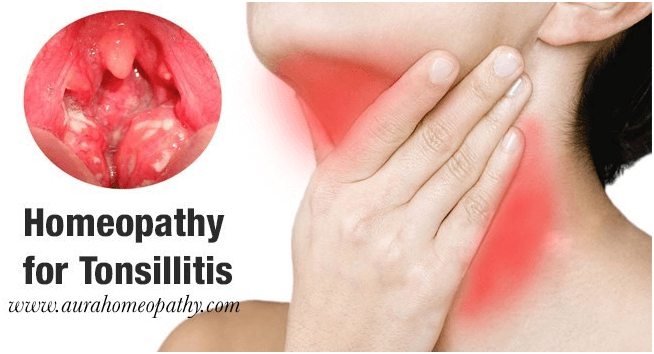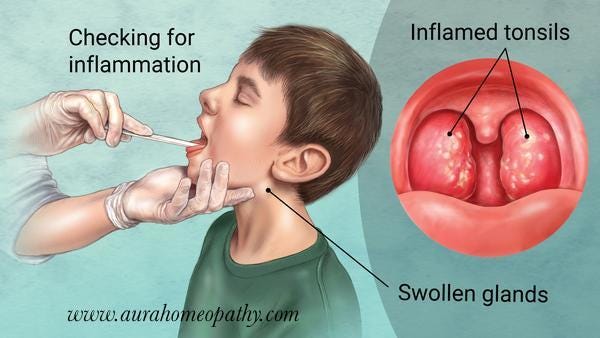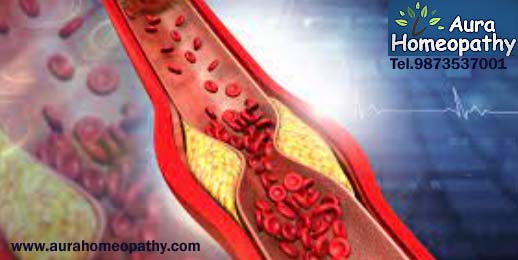Home / All Post / 10 Best Homeopathic Medicine For Sore Throat Tonsillitis: Streptococcal Pharangitis
10 Best Homeopathic Medicine For Sore Throat Tonsillitis: Streptococcal Pharangitis

Sore throat is a very uncomfortable symptom, which usually occurs in both adults and children. In general, sore throat is caused by an inflammation of the tonsils or pharynx, which we call tonsillitis and pharyngitis, respectively. When both are inflamed, very common situation, we say that the patient has a pharyngotonsillitis.
In most cases, the sore throat originates from an infection. Pharyngitis and viral tonsillitis are the most common causes of inflamed throat, but bacterial infections are also common sources of inflammation in the throat.
Among the bacteria that cause pharyngitis or tonsillitis, Streptococcus pyogenes (Streptococcus group A) deserves more prominence, not only because it is the most common form of bacterial pharyngotonsillitis, but also because it is the most common form of throat infection complications. The Streptococcus pyogenes is responsible for about 30% of cases of pharyngitis in children and 10% in adults.
In this article we will specifically talk about tonsillitis and pharyngitis caused by Streptococcus pyogenes . Let’s address your symptoms, forms of transmission, diagnostic methods, possible complications and treatment options.
What Is Streptococcus Pyogenes — Streptococcus Group A
Bacteria of the genus Streptococcus have several different species, many of them capable of causing infections in humans. Just as examples, Streptococcus pneumoniae is a common cause of pneumonia , Streptococcus agalactiae can cause serious infections in newborns and Streptococcus viridans is a common cause of endocarditis .
But Streptococcus pyogenes does not only cause pharyngitis and tonsillitis, it can also be responsible for other infections, such as impetigo, erysipelas and psoriasis Guttate, a rare form of Psoriasis. In this article, however, we will focus only on pharyngitis and its complications. The Streptococcus pyogenes , target of our article, is also known as beta-hemolytic streptococcus group A. This kind of Streptococcusis the most common cause of sore throat of bacterial origin. That is, if a patient has an inflammation of the throat caused by a bacterium, the chance of this bacteria being the Streptococcus pyogenes is very high.
Transmission Of Streptococcal Pharyngitis
The bacteria Streptococcus pyogenes is highly contagious and can be transmitted through coughing, sneezing, droplets of saliva emitted during speech or by sharing cutlery or glasses. Hands contaminated by respiratory secretions are also an important vehicle for transmission of Group A Streptococcus.
Generally, children between 3 and 14 years old are the group with the highest risk of contamination. However, not all people who become infected with Streptococcus pyogenes will develop inflammation of the throat. Adults often come in contact with the bacteria and do not develop symptoms.
There are also cases of patients who come in contact with Streptococcus pyogenes , do not develop symptoms, but become carriers of the bacterium in the oropharynx. In winter, when people spend more time together indoors, about 20% of school-age children become asymptomatic carriers of Group A streptococcus in their oropharynx.
These asymptomatic carriers can remain with the bacteria for several months without presenting any problems. In many of these carriers, the bacteria only become active when the patient develops a viral respiratory infection. In these cases, it is very difficult to distinguish between pure viral pharyngitis or opportunistic bacterial pharyngitis, which took advantage of inflammation caused by a virus to become active.
These carriers are not usually the source of transmission of the bacteria while they are asymptomatic. However, if at any point the bacterium becomes active and causes infection of the throat, the risk of contagion becomes real.
Symptoms Of Streptococcal Pharyngitis
The incubation period of Streptococcus pyogenes , ie the time interval between contamination and the onset of the first symptoms, is 24 to 72 hours, but may be as long as 2 weeks in some cases.
The main symptoms of streptococcal pharyngitis and / or tonsillitis are sore throat, fever, headache and redness of the pharynx and tonsils. These signs and symptoms, however, do not help much in diagnosis, as they are common to almost all types of pharyngitis, especially pharyngotonsillitis of viral origin.

Bacterial & Viral Tonsilitis
Bacterial pharyngitis
In fact, it is not always easy to distinguish streptococcal pharyngitis from pharyngitis of viral origin. However, some physical examination findings may help. For example, the following signs speak highly in favor of Streptococcus pyogenes pharyngitis :
• Tonsils swollen and pus (presence of plaques or white spots on the tonsils or pharynx)
• Pharynx inflamed and with pus.
• Increased and painful lymph nodes in the anterior region of the neck, just below the mandible.
• Presence of petechiae on the palate (several red spots on the roof of the mouth).
• Inflammation and swelling of the uvula (bell or throat sinus).
• Abrupt onset and rapid development of symptoms.
However, as noted above, it is entirely possible for a patient to develop a bacterial pharyngitis in the midst of a viral respiratory infection, which makes the distinction between throat inflammation of vital and bacterial origin very difficult. On the other hand, the presence of characteristic symptoms of viral infection, such as sneezing, coughing, runny nose, hoarseness, conjunctivitis, diarrhea or mouth ulcers, direct the diagnosis more to a viral pharyngotonsillitis such as flu or cold.
The most specific signs of bacterial pharyngitis / tonsillitis are the petechiae on the palate and the presence of pus in the pharynx or tonsils. Nevertheless, none of them allows us to say with 100% certainty that we are facing bacterial pharyngitis, since 5 to 10% of non-bacterial throat inflammations may have these signs.
Therefore, in less than 50% of cases of throat inflammation there is a set of signs and symptoms specific enough that allow the doctor to close the diagnosis of streptococcal pharyngitis only by physical examination. In most cases, certainty of diagnosis is only obtained through complementary tests, such as the rapid test or culture of pharyngeal material, which indicate the presence of Streptococcus pyogenes in the oropharynx, as we will see later.
Streptococcal pharyngitis usually has a limited duration. Usually, the sore throat disappears within 5 days, even without antibiotic treatment.
Complications Of Streptococcal Pharyngitis
The major problem with streptococcal pharyngitis is not the inflammation of the throat itself, but the risk of complications. Children are the main victims of these complications, being the group most in need of treatment with antibiotics for prevention.
Some complications are serious, even at risk of death, as is the case of Streptococcus toxic shock syndrome. Others can cause internal organ damage, such as the kidneys in post streptococcal glomerulonephritis, or the heart in rheumatic fever. There are also simpler situations, such as scarlet fever, which is a rash of skin that is usually benign and easy to treat.
Among the possible complications of streptococcal pharyngotonsillitis, we can highlight:
• Rheumatic fever.
• Post-streptococcal glomerulonephritis.
• Scarlet fever.
• Pediatric autoimmune neuropsychiatric disorder associated with group A streptococcal infection (PANDAS).
• Toxic shock syndrome by streptococcus.
• Abscess in the tonsils.
• Otitis media.
• Bacterial sinusitis.
• Meningitis or cerebral abscess.
It is important to note that most cases of streptococcal pharyngotonsillitis do not present complications.
Diagnosis Of Streptococcal Pharyngitis
Properly identifying whether pharyngitis is of bacterial, viral or non-infectious origin is important when designing strategies to prevent complications and discontinuation of contagion for others, as well as to minimize the unnecessary use of antibiotics in children and adolescents who have inflammation of non-bacterial origin, which represents the majority of cases.

Throat Swab Streptococcus Infection
Throat Swab — collection of material for the detection of streptococcus
Currently, the most widely used method for detecting strep throat is through the rapid detection test of Group A Streptococcus. This test is done through a swab, which is a kind of long swab that is used to collect material of the tonsils. This test can identify the presence of Streptococcus pyogenes in the oropharynx and its result is obtained in a few minutes.
If the test is negative but the suspected strep throat is very strong, the material collected by the swab can be sent to culture, which is a more reliable method than the rapid test. The disadvantage of the crop is that the result is only available after 48 hours.
Homeopathy Treatment Of Streptococcal Pharyngitis
The objective of Aura Homeopathic treatment is to increase immunity of the body so as to eradicate Group A streptococcus from the oropharynx For Help The Aura Homeopathy treatment has the following benefits:
- Reduction in the duration and severity of signs and symptoms.
- Reduction in the incidence of complications.
- Reducing the risk of transmission of bacteria to other people.
10 Best Homeopathic Medicine For Sore Throat: Streptococcal Pharangitis
Arnica Montana: Patient develop pharangitis after non-stop talking for long time period, he complaints of difficulty in swallowing along with hoarseness of voice due to history of injury to pharynx and larynx.
Phytolacca Decandra: Pharangitis along with red swollen tonsils. Patient complaints of difficulty in swallowing along with hoarseness of voice. Pain in throat extend up to ears. Dr.Abhishek recommended gargle with phytolacca mother tincture for early recovery.
Aconite: Patient complaints of pharangitis due to sudden exposure to cold, dry and windy weather conditions. Sore throat with great thirst. Patient is very restless and anxious, with face colour changing from pale to red.
Lachesis: Pharangitis, which is predominantly left sided, along with pain and inflammation. Throat is swollen, with severe pain which gets worse at night, when patient wake up and after drinking warm beverage like tea and coffee. Patient cannot bear constrictive dress, specially turtle neck dress and tie, because of great sensitivity to touch specially in throat region.
Mercurius Vivus: Patient complaint of sore throat with rawness and burning sensation with excessive saliva dripping from the mouth. Patient is very sensitive to both cold and heat. Merc viv patient have bad odor of sweat and breath, with metallic taste in mouth. Pharangitis with aggravation at night.
Belladonna: Sore throat with red flushed face, intense pain and high fever. Patient complaint of severe pain in throat, throat is red, swollen, and along with throbbing pain. Pain get worse at night, more towards right side. Right sided Constricted pain.
Hepar Sulphuris: Pharangitis with splinter like feeling in the throat. Sore throat with pain extended to ears. Patient is very irritable and chilly, feels good in warm environment in general and after drinking warm water. Patient is hypersensitive to light, noise and motion.
Gelsemium: For sore throat that develops slowly and gets worse steadily over time. Patient feels very weak and heavy. Along with sore throat, patient complaint of flu-like symptoms including chills and fever.
Phytolacca: For sore throat that is hot with pain and is red or blue in color. Warm drinks aggravate pain. Pain in throat while swallowing due to glandular swelling on neck. Throat pain worse at back side of throat, with a sensation of lump.
Lycopodium: Best for sore throat with pain on right side. At times patient complaints that sore throat pain starts from right side and moves to left side along with chocking sensation, as if a ball stuck in his throat. Pharangitis gets amelioration with warm food and drinks. Pain aggravates between 4:00 p.m. and 8:00 p.m.
Recent Post
ORDER TREATMENT ONLINE
Our Homeopathy treatment is now just a few clicks away.
Learn More...
Select your disease (s)
(Treatment for additional diseases charged at 50%)




